Dodge Ram
1500 Rear Brake Pads Replacement Guide
How to change the rear disc brake pads of
a 4th generation 2009-2013 Dodge RAM 1500 with picture illustrated steps.
By Paul B. Michaels Author & Photographer Auto Mechanic Since 1989 |
||
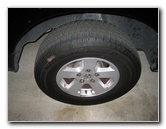 Ram 1500 Rear Wheel |
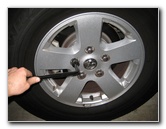 Loosen 5 Lug Nuts |
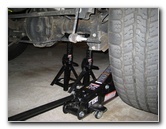 Raise Rear of Vehicle |
| This
automotive "how-to" guide was specifically written to assist owners
of the fourth generation (2009, 2010, 2011, 2012, and 2013) Dodge
RAM 1500 truck in replacing the rear disc brake pads. Owners of other Dodge, Ram Trucks, or Chrysler vehicles such as the Dart, Avenger, Challenger, Charger, Durango, Dakota, Journey, Grand Caravan, 2500, 3500, 4500, 5500, C/V Tradesman, 200, 300, Aspen, Jeep Commander, Grand Cherokee and Town & Country minivan may also find these DIY instructions to be helpful. The items needed to complete this rear brake job include a floor jack, jack stands, a tire iron, a 10mm socket with ratcheting wrench, a packet of brake parts lubricant, a "C" or "F" clamp, brake parts cleaner spray, a tube of brake caliper grease and a set of new rear brake pads. A few compatible aftermarket brake pads include the following with their part numbers: ACDelco 14D967M or 17D1400MH, Wagner MX967A, Raybestos ATD967M, Monroe DX898, Bendix MRD967, Akebono ACT898 and Power Stop 16-898. |
||
|
|
||
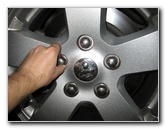 Spin Off 5 Lug Nuts |
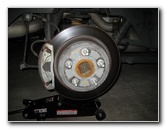 Rear Caliper & Rotor |
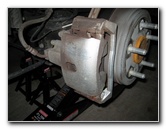 Rear Brake Caliper |
| The first two steps
are to park the truck on a level surface and chock the front wheels to
prevent the vehicle from moving. Slightly loosen the 5 lug nuts with the tire iron. Then raise the rear of the vehicle with the floor jack and securely support it with at least two jack stands. I prefer to work on one side of the vehicle at a time for extra safety. Spin off the 5 lug nuts and set them aside in a safe place. Pull off the rear wheel to reveal the brake caliper, bracket and rotor. |
||
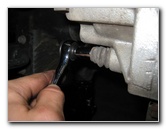 Loosen Lower Caliper Bolt |
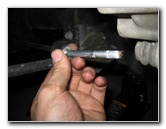 Remove 10mm Bolt/Pin |
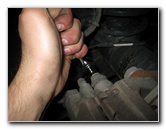 Loosen Upper Caliper Bolt |
| Loosen the upper
and lower caliper bolts on the back side of the caliper by turning them
clockwise (as seen from the outside of the vehicle).
Remove the two combination caliper bolt and slider pins. Set them aside in a safe place. |
||
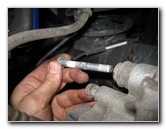 Remove Upper Bolt/Pin |
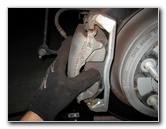 Pull Off Rear Brake Caliper |
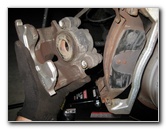 Rear Caliper Removed |
| Pull the rear brake
caliper out of the bracket and securely rest it on the suspension arm.
You may also choose to hang it from the suspension spring with a piece of rope or a bungee cord. |
||
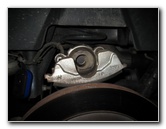 Rest Caliper On Suspension |
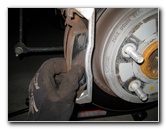 Remove Old Outer Pad |
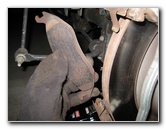 Pull Off Old Inner Pad |
| Pull out the old
outer and inner brake pads from the bracket.
Keep one of them nearby to use later for compressing the piston. Thoroughly clean off the brake rotor, caliper bracket, brake caliper assembly and the lug nut studs with brake parts cleaner spray. Do not use compressed air or blow with your mouth to clean off the brake parts since breathing in brake dust can be harmful to your health. Brake dust can be carcinogenic (causes cancer) if inhaled.
To remove the existing rotors and install new ones, just remove the two bolts on the rear of the caliper bracket that attach it to the steering knuckle. Then loosen the old rotor with a rubber mallet, pull it off, and slide the new one in its place. |
||
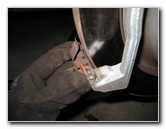 Replace Anti-Rattle Clips |
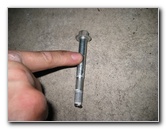 Lubricate Caliper Slider Pins |
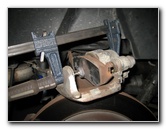 Attach "C" Clamp |
| I've always had
great experiences with the Wagner
ThermoQuiet MX967A brake pads and they have great reviews on Amazon.
I also like how they have built in insulators so you they don't require
backing plates, shims or disc brake quiet gel. If your new set of rear brake pads came with new metal pad abutment or "anti-rattle" clips, pull the old ones out of the top and bottom of the bracket before installing the new units. Apply a thin layer of brake caliper grease to the smooth part of the combination caliper bolts and slider pins. In order for the caliper to fit over the thicker new brake pads, the caliper piston needs to be compressed backwards. Attach the "C" or "F" clamp to the caliper piston using the back of an old brake pad to evenly distribute the force. |
||
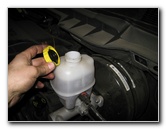 Remove Brake Fluid Cap |
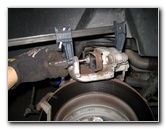 Compress Caliper Piston |
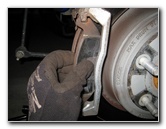 Install New Rear Pads |
|
|
||
| Move to the engine
bay and twist off the brake fluid cap by turning it 1/4 turn counter
clockwise.
Removing the brake fluid cap will allow the brake fluid to more easily travel backwards through the system when you compress the caliper piston. Turn the handle of the "C" clamp to compress the caliper piston backwards until it flush with its rubber dust boot. Repeatedly check that the brake fluid reservoir does not overflow while compressing the piston. Clean up any spilled brake fluid immediately since brake fluid can easily damage painted surfaces. Try to avoid pinching or otherwise damaging the caliper piston's rubber dust boot. Replace the brake fluid reservoir cap after you are done compressing the piston since the fluid is hygroscopic (absorbs moisture) and can become contaminated. |
||
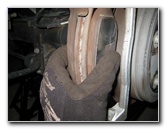 Push Pads Against Rotor |
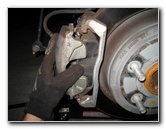 Replace Rear Caliper |
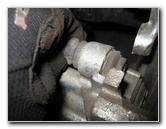 Line Up Bolt Holes |
| Apply a thin layer
of brake parts lubricant to any area where there is metal on metal contact
such as the outer ring of the caliper piston. Do not apply grease to the
friction surface of the new pads. Install the new inner and outer brake pads in to the bracket. Lower the brake caliper over the new pads and in to the bracket. Line up the bolt holes in the caliper with the corresponding holes in the bracket. |
||
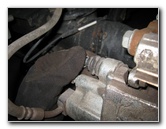 Insert Lower Bolt/Pin |
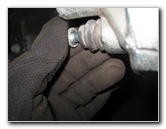 Insert Upper Caliper Bolt |
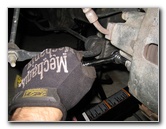 Tighten Lower 10mm Bolt |
| Insert the two
caliper bolts/pins and thread them in by hand a few turns to prevent them
from becoming cross threaded. Tighten the caliper bolts with the 10mm socket and ratcheting wrench by turning them counter clockwise (as seen from the outside of the vehicle) to just past hand tight or about 24 ft lbs of torque. Double check that both the upper and lower combination caliper bolts / caliper slider pins are tight before moving on to the next steps. |
||
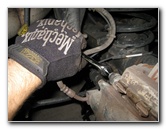 Tighten Upper Caliper Bolt |
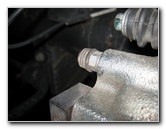 Rubber Valve Cap |
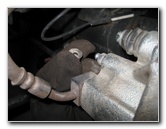 Brake Fluid Bleeder Valve |
If your brake pedal previously felt soft or spongy, the brake fluid may be contaminated with water or the brake lines may contain some air bubbles. It would be best to bleed the brake lines at this time in order to flush out the old fluid and replace it with fresh DOT3 brake fluid. For more on this topic, check out my Brake Line Fluid Bleeding With An Assistant DIY Guide or alternatively the Brake Line Fluid Bleeding With A Power Bleeder Guide. The brake fluid bleeder valve is located on the back side of the caliper just below the upper caliper bolt/pin. It is covered by a black rubber valve cap. |
||
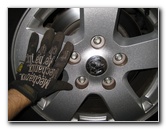 Replace Rear Wheel |
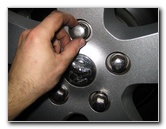 Spin On Five Lug Nuts |
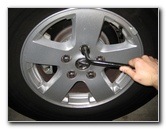 Slightly Tighten Lug Nuts |
| Replace the rear
wheel and spin on the five lug nuts by hand to prevent them from becoming
cross threaded. Slightly tighten the lug nuts with the tire iron. |
||
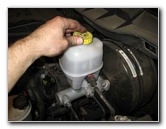 Replace Brake Fluid Cap |
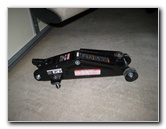 Lower Vehicle From Stands |
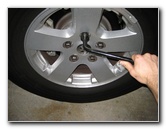 Torque Lug Nuts |
| Lower the truck
from the jack stands using the floor jack until the rear wheel holds enough
weight to keep it from spinning. Progressively tighten the lug nuts in a criss-cross or star pattern with the lug nut wrench to about 1/4 to 1/3 turn past hand tight. It would be best to use a torque wrench or an impact wrench with a torque stick to tighten the lug nuts to about 135 ft lbs of torque. Sit in the driver's seat of the vehicle and pump the brake pedal a few times to restore the brake line pressure. Check the brake fluid in the reservoir and verify that it is at the proper level. If it is low, add some DOT 3 fluid. If you don't have a torque wrench, be sure to double check that the lug nuts are tight after a short test drive. To break in your new front brake pads, just drive normally for the first few hundred miles while trying to avoid any hard or "panic" stops which may glaze over the new pads and cause them to be noisy and not perform as well. It's also a good idea to regularly check your driveway for drops of brake fluid which may indicate a leak, check the brake fluid level in the reservoir, and also verify that the lug nuts are still tight. For more,
check out my other
Dodge RAM 1500 Repair & Maintenance Guides. |
||
| If you found this guide to be helpful,
please consider making a small donation by clicking on the PayPal.com
"Donate" button located to the right of this paragraph. Thank you!
(Note: I am not a registered charity. Donations are not tax deductible.) |

